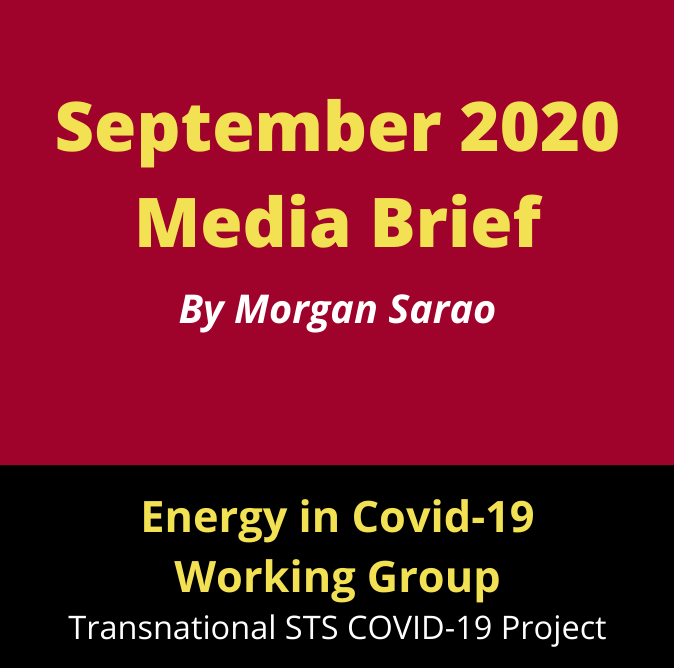
Morgan Sarao, James Adams, Briana Leone, Ali Kenner, and Andrew Rosenthal. "September Research Brief - October 12th 2020" Energy in COVID-19. The Energy Vulnerability Project. Platform for Experimental and Collaborative Ethnography. Retrieved from https://housingenergy.info/content/energy-covid-19-september-research-brief
Utility moratoria, which have guaranteed power to residents across the United States, have continued to reach their deadline throughout September. State-mandated suspensions on utility shut-offs due to nonpayment as a result of COVID-19 are now in place in 20 states and the District of Columbia. The other 30 states have moratoriums that have expired or never implemented state-mandated moratoriums. Eight states have moratoriums that will expire in October if not extended: Virginia, Colorado, Indiana, Arkansas, Washington, Vermont, New Mexico, and Connecticut. This means that 32.2 million people may lose protection from utility shut offs during the month of October. About 9.5 million people are currently unemployed in states that are set to have their shutoff protections expire on or before October 1, according to the report’s analysis of the latest monthly data from the Bureau of Labor Statistics. Another 10 million of the households in those states are currently below the federal poverty line. As the COVID-19 pandemic and subsequent economic recession persists, an unprecedented number of utility shut-offs are anticipated, because in some states, as many as a third of households are behind on payments, and will disproportionately affect those at or below the poverty line, including Black and Hispanic households, families with young children, people with disabilities and those who use electronic medical devices.
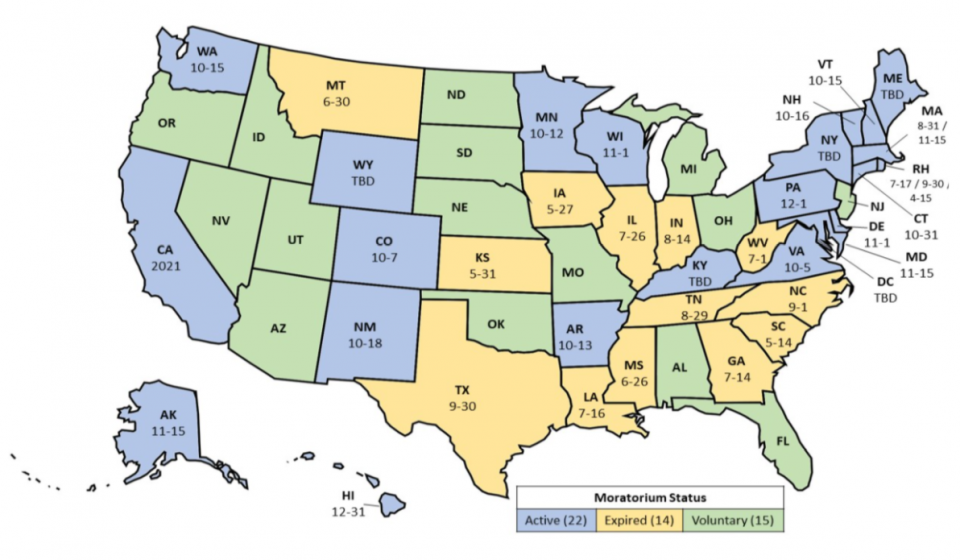
Summary of State Utility Shut-off Moratoriums due to COVID-19. (2020, October 14). Retrieved October 16, 2020, from https://neada.org/utilityshutoffsuspensions/
A 'TIDAL WAVE' OF POWER CUTS MAY BE COMING AS ELECTRIC COMPANIES RESUME SHUTOFFS
Incomes of Americans have been drastically reduced in recent weeks as COVID19 related relief programs have reached their deadlines without extensions. The federal eviction moratorium ended on July 24th, and the program providing an extra $600 in unemployment benefits expired on July 30th, and with state wide utility moratoriums/utility company pledges to keep customers winding down, many disadvantaged Americans face utility shutoffs amidst an ongoing pandemic and economic recession.

Suttell, S. (2020, September 28). Moratoriums on utility shut-offs are about to end, potentially leaving many Americans in the dark. Retrieved October 16, 2020, from https://www.crainscleveland.com/scott-suttell-blog/moratoriums-utility-s...
PRESSURE BUILDS AS FLORIDA ADVOCATES CALL FOR UTILITY, HOUSING RELIEF
Following the end of the moratoria, Floridians are facing disconnections and evictions. Many are now calling for protections for vulnerable populations. What is particularly interesting and relevant to this article is it is part of months-long and months-persistent thematic of disconnections and evictions faced by lower income and vulnerable populations. Additionally, in an overwhelming and recurring discussion of compounded vulnerabilities, the article points to black, immigrant, and poor communities being most hardly hit by the pandemic and by utilities resuming shut-offs. One of the major points to note in the article is the letter written by the Connected in Crisis Coalition, to the Governor of Florida. The letter urges Gov. DeSantis to extend moratoria to June 2021. As in other discussions on the response to the pandemic, this article points to short-term solutions (being the moratoria), but little seems to be envisioned for more permanent and structural solutions. One reflection on this article, and articles of the like, should take into account how, perhaps, a crisis like the one being currently felt calls for more short-term solutions rather than long-term solutions.
ALANA SEMUELS, "A 'Tidal Wave' of Power Cuts May Be Coming as Electric Companies Resume Shutoffs", contributed by Morgan Sarao, The Energy Rights Project, Platform for Experimental Collaborative Ethnography, last modified 21 September 2020, accessed 31 May 2022. https://energyrights.info/content/tidal-wave-power-cuts-may-be-coming-el...
Malena Carollo, "Pressure builds as Florida advocates call for utility, housing relief", contributed by Briana Leone, The Energy Rights Project, Platform for Experimental Collaborative Ethnography, last modified 30 September 2020, accessed 31 May 2022. https://energyrights.info/content/pressure-builds-florida-advocates-call...
Jim kenny and William Hite Jr., " Help All Students #LogOnPHL ", contributed by Andrew Rosenthal, The Energy Rights Project, Platform for Experimental Collaborative Ethnography, last modified 1 October 2020, accessed 31 May 2022. https://energyrights.info/content/help-all-students-logonphl
Joseph W. Kane and Ranjitha Shivaram, "How clean energy jobs can power an equitable COVID-19 recovery", contributed by Alison Kenner, The Energy Rights Project, Platform for Experimental Collaborative Ethnography, last modified 2 October 2020, accessed 31 May 2022. https://energyrights.info/content/how-clean-energy-jobs-can-power-equita...
Kristen A. Graham, "Free internet coming for 35,000 Philly families: city, schools, Comcast to spend $17M on digital equity plan", contributed by Andrew Rosenthal, The Energy Rights Project, Platform for Experimental Collaborative Ethnography, last modified 28 August 2020, accessed 31 May 2022. https://energyrights.info/content/free-internet-coming-35000-philly-fami...
Rajiv Shah, "Why expanded energy access is key to an equitable COVID-19 recovery", contributed by Alison Kenner, The Energy Rights Project, Platform for Experimental Collaborative Ethnography, last modified 2 October 2020, accessed 31 May 2022. https://energyrights.info/content/why-expanded-energy-access-key-equitab...
Roberto E. Barrios, "What Does Catastrophe Reveal for Whom? The Anthropology of Crises and Disasters at the Onset of the Anthropocene", contributed by Alison Kenner, The Energy Rights Project, Platform for Experimental Collaborative Ethnography, last modified 13 July 2020, accessed 31 May 2022. https://energyrights.info/content/what-does-catastrophe-reveal-whom-anth...
Sara Wilkinson, Caroline Porto Valente and Alan Morris, "Here’s our chance to relieve energy poverty through post COVID stimulus", contributed by Alison Kenner, The Energy Rights Project, Platform for Experimental Collaborative Ethnography, last modified 2 October 2020, accessed 31 May 2022. https://energyrights.info/content/here’s-our-chance-relieve-energy-poverty-through-post-covid-stimulus
Shalanda H. Baker, "How to create anti-racist energy policies", contributed by Alison Kenner, The Energy Rights Project, Platform for Experimental Collaborative Ethnography, last modified 2 October 2020, accessed 31 May 2022. https://energyrights.info/content/how-create-anti-racist-energy-policies
Travis Fedschun, "California wildfire threat spurs utility PG&E to cut power to 89,000 customers", contributed by Briana Leone, The Energy Rights Project, Platform for Experimental Collaborative Ethnography, last modified 30 September 2020, accessed 31 May 2022. https://energyrights.info/content/california-wildfire-threat-spurs-utili....
The articles gathered for our September research brief continue to explore the manifold ways in which COVID-19 has revealed and amplified disparities produced by inhumane energy systems. Energy systems--along with the infrastructures of which they are composed--are always more than mere networks for the transport of people, goods, and information; they are also (contested) political projects. The placement, technological makeup, and financial models that characterize energy systems represent specific techniques and strategies of power put towards the materialization of economic ideologies, aesthetic sensibilities, ethical commitments, and sensual desires (Larkin 2013). While the reports continue to range in topic and coverage, this month's articles focus more narrowly on “energy imaginaries” where an energy equitable COVID-19 recovery is envisioned.
As we hit the six month mark of the COVID-19 pandemic, conversations are emerging regarding what COVID-19 recovery policies could or should entail. Thus, in this section of our brief, we consider diverse ways of imagining the future of energy and its role in enabling a just recovery from COVID-19.
The concept of the sociotechnical imaginary has offered many STS scholars a productive way to analyze collective imaginations of the speculative futures of technology (Jasanoff and Kim 2009). As these scholars argue, even the most robust, data-centric conceptions of technological futures are still inherently speculative and therefore encode the culturally inflected desires and fantasies of the speculators (Williams 2019). However, what is particularly interesting about speculations on energy futures within COVID-19 recovery plans--especially of a “just recovery”--is the required engagement with the past in addition to any ideations of the future; i.e. how the socio-structural and infrastructural conditions preceding the disaster led to the (unequal) distribution of its devastation.
It is well recognized that the economic downturn induced by COVID-19 has exposed and accelerated many inequities that predate the pandemic. Among these, disparate access to electricity and the racialized violence embedded within current energy systems have proven to be uniquely consequential. Globally, there are 800 million people still living without electricity, and yet another 1.2 billion people lack reliable electricity access, which further isolates communities that are experiencing energy poverty and other burdens. In the United States, for those who do have energy access, electric utilities disproportionately extract wealth from the lowest-income Americans, who also tend to live in communities with the poorest air quality. And these are the same communities that have less access to clean, localized energy sources. During the pandemic, these environmental injustices created a deadlier set of health risks, as it’s been found that long-term exposure to air pollution can increase the risk of dying from COVID-19.
The articles in this section explore critiques of this legacy of environmental racism and various entry points for an energy just COVID-19 recovery, such as investments into a clean energy economy, energy efficiency retrogrades, and high-speed broadband, and prioritizing those investments in communities where current energy systems not only fail to serve them but cause them disproportionate harm.
HOW TO CREATE ANTI-RACIST ENERGY POLICIES
COVID-19 has exposed longstanding inequality in the United States, including the ways in which energy systems are racially disparate. Predating COVID-19, households paying the highest portion of their income for energy and confronted with difficult decisions about how to pay their utility bills are disproportionately Black, Latinx and Indigenous. The legacy of environmental racism also means that Black people are more likely to live near coal-fired power plants than other people, and Black, Latinx and Indigenous people routinely absorb more of the toxic byproducts of our fossil-fuel-based energy system. And scholars have argued that this relegation of deadly pollutants to black and brown communities was far from naive, but intentional (Pastor et al. 2001).During the pandemic, these environmental injustices create a deadlier set of health risks: researchers at Harvard Chan School of Public Health recently found that long-term exposure to air pollution can increase the risk of dying from COVID-19. Communities of color also face an increased risk of experiencing energy insecurity (a condition where one is unable to pay for energy), and as COVID-19 moratoria on utility shut offs come to an end, millions of americans, and disproportionately Americans of color, are on the verge of having their utilities disconnected due to the current pandemic. Communities of color are therefore paying more money into an energy system that is killing them.
This unjust energy divide is more than apparent, and the urgency of the COVID-19 pandemic has made it clear that there needs to be energy system reform. Shalanda Baker’s proposed anti-racist approach to energy policy would address the disproportionate burdens experienced by Black and Latinx americans by establishing a national policy to end utility shutoffs until there is a vaccine or therapeutic treatment to combat COVID-19. She additionally advocates for a cap on household energy expenditures that would limit the amount a household pays for electricity at 6% of overall household income. If that household is within a community with lower air quality, the cap would be lower, and not exceed 2% of overall household income. Lastly, Baker argues for prioritizing investments in clean, local energy in communities of color, especially communities on the frontlines of climate change and environmental harm.
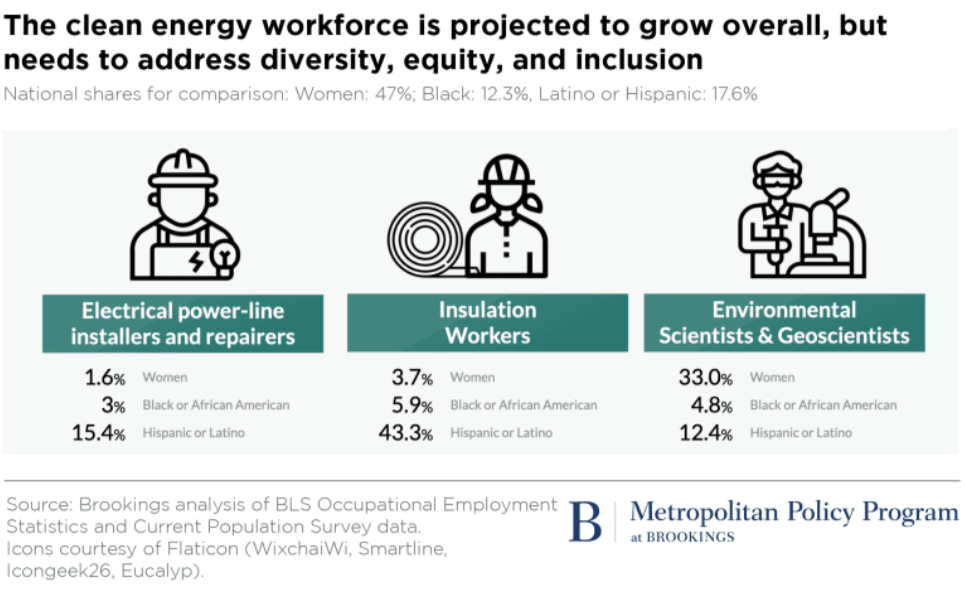
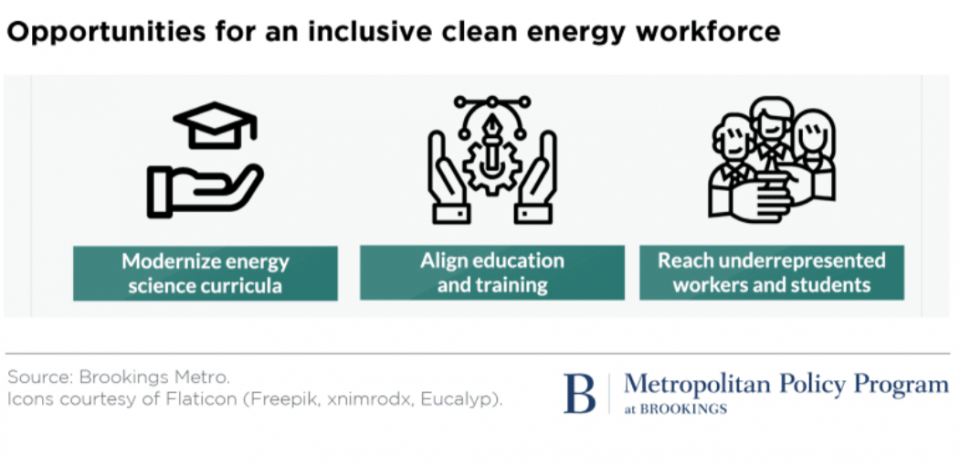
Joseph W. Kane and Ranjitha Shivaram. (2020) "How Clean Energy Jobs Can Power an Equitable COVID-19 Recovery." The Avenue. Brookings Institute. 10 September. https://www.brookings.edu/blog/the-avenue/2020/09/10/how-clean-energy-jo...
HOW CLEAN ENERGY JOBS CAN POWER AN EQUITABLE COVID-19 RECOVERY
Democratic presidential candidate Joe Biden’s climate plan emphasizes investing in energy infrastructure, which would create jobs and simultaneously aid in the United State’s transition to a clean energy economy. His proposal prioritizes social and economic equity in this transition, and hopes that millions who are unemployed due to COVID-19 can benefit from these long term career opportunities. As previous Brookings Metro research on advancing inclusion through clean energy jobs has shown, policymakers need to recognize and invest in careers that offer equitable wages, promote transferable skills, and pose lower formal educational barriers to entry. Clean energy jobs offer all three benefits, making them crucial for the post-pandemic recovery.
According to Brookings, occupations in clean energy provide higher wages while posing lower formal education barriers to entry compared to all jobs nationally. Nearly two-thirds of solar installers (62.3%) have a high school diploma or less, as do nearly three-quarters of construction workers (73.2%)—both significantly higher than the national share for all occupations (32.2%). These occupations also tend to pay higher wages, especially for workers just starting out their careers or at lower ends of the income spectrum. Although the clean energy workforce is projected to grow, there is a need for this workforce to address gender and race disparities: current data shows that there aren’t many women in high-skill trade positions such as electrical power-line installers (1.6%) and insulation workers (3.1%), relative to the national average (47%). At the same time, the share of Black workers falls well below the national average of 12.3%, with shortfalls evident across a variety of positions in science, technology, engineering, and math (STEM) fields, such as environmental scientists (4.8%). In addition to addressing gender and racial disparities, there will be a need for this transition to retrain and connect displaced workers in traditional energy industries (coal, oil, and gas) with careers in clean energy, especially given the potential mismatch in the geographic location and current skill set of existing energy workers. As COVID-19 and related burdens persist and necessitate policy that addresses the multiplicity of crises facing the United States, there is an opportunity to create long-term platforms for economic equity and growth, centered around a more diverse range of workers in the clean energy economy.
WHY EXPANDED ENERGY ACCESS IS KEY TO AN EQUITABLE COVID-19 RECOVERY
Although the pandemic accelerated digitization and economic interconnectedness, it has further isolated billions of people living without reliable electricity, making it clear that making progress on UN’s Sustainable Development Goal 7--ensuring access to affordable, reliable, sustainable and modern energy for all--is required in order to make an equitable recovery from COVID-19. On top of a complete lack of access to energy for billions of people, the energy reality for millions of individuals consists of fractured access to unsustainable energy which degrades the health of individuals and the environment in which they live. An equitable recovery from COVID-19 requires prioritization of investments and resources such as distribution of vaccines and support services, access to power for the billions living without it, and public-private investment in green infrastructure in high-risk communities around the world. Solar-powered mini-grids can be a key part of enabling a sustainable, equitable recovery by providing renewable, reliable power to those living in energy poverty and simultaneously reducing reliance on fossil fuels.
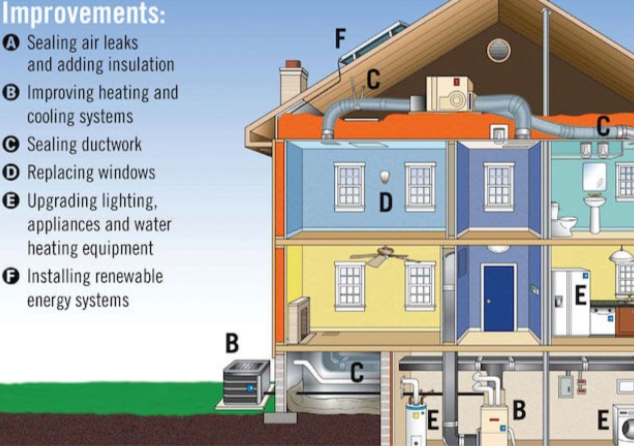
Sara Wilkinson, Caroline Porto Valente, Alan Morris. (2020) "Here’s our chance to relieve energy poverty through post COVID stimulus." The Fifth Estate. 17 September. https://www.thefifthestate.com.au/columns/spinifex/heres-our-chance-to-r...
HERE’S OUR CHANCE TO RELIEVE ENERGY POVERTY THROUGH POST COVID STIMULUS
Australia faces three major, growing challenges in their energy sector: 1) reducing greenhouse gas emissions, 2) increasing energy security and reliability, particularly during peak demand and extreme weather events such as heatwaves, and 3) ensuring affordable energy services for vulnerable households in a poorly regulated market. Around 1 in 4 households in Australia experience energy poverty, or the inability to pay energy bills, restricted energy consumption to the detriment of health and wellbeing, and having relatively low income so spending a high proportion of it on energy. This situation is only expected to become worse as more individuals are spending time at home due to COVID-19. Contributing to this figure is the fact that Australia’s existing housing stock is old and was constructed prior to the introduction of the first national housing minimum energy efficiency requirements in 2005.
COVID-19 has created an opportunity for Australia to simultaneously address energy poverty, reduce its carbon footprint, and stimulate the economy. This can be achieved by establishing a nation-wide program to subsidise energy retrofits, where jobs would be created in quoting for and installing energy efficiency retrofit measures such as insulation. These new high-quality jobs and subsequent reductions in energy bills would effect an increase in disposable income for households that would be ploughed back into the economy in other sectors.
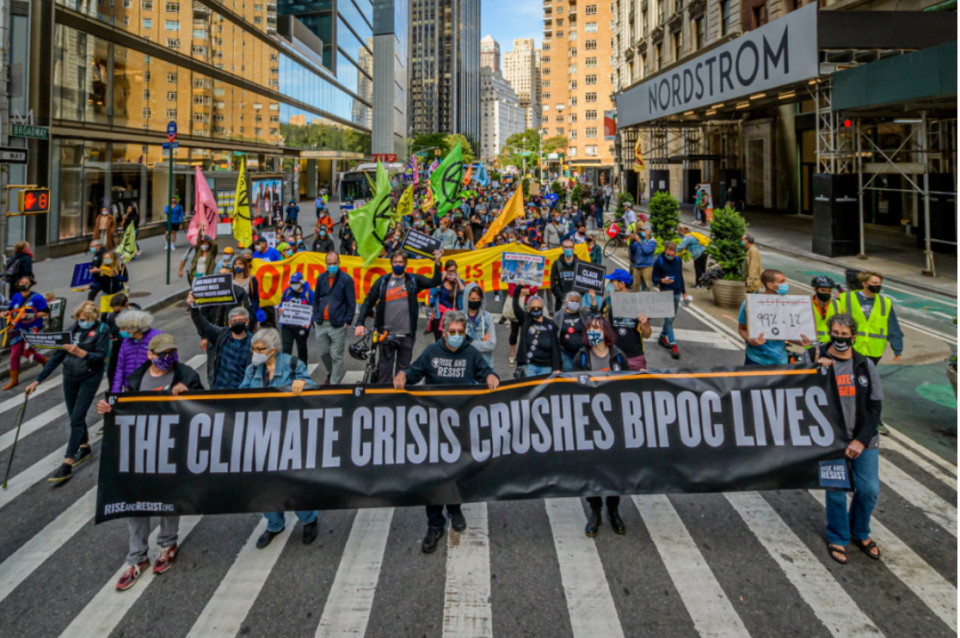
Photo by Erik McGregor/LightRocket via Getty Images: https://www.wbur.org/cognoscenti/2020/09/23/utility-bills-energy-climate...
A persistent theme in this working group’s research briefs has been the appearance of intersecting and compounded vulnerabilities during COVID-19 (see also Fortun 2020), and an increased severity of burdens for populations who bear the brunt of structural disparities inherent to health, energy, and education systems and realities. This situation reflects the tight coupling of failing systems that characterizes what Kim Fortun has called “Late Industrialism” (2012). As wildfires continue to ravage the west coast, we see in the article below how threats posed from both the climate crisis and COVID-19 are creating unprecedented burdens. PG&E, California’s largest utility company, is temporarily shutting off power in an effort to try and prevent wildfires from being sparked from utility equipment. This strategy, however, makes no long term impact to the utility’s transmission infrastructure, which has long been in need of maintenance and repair. In the past, PG&E was charged for the damages and fatalities of multiple California fires, leading the newest iteration of the company to create a trust of $13.5 billion to cover the damages. They are also able to draw from a $20 billion fund created by the California Legislature to cover wildfire damages. Meanwhile, local residents--who are currently under stay-at-home orders and rely on their residential power for essentials such as working and schooling--will have to choose between staying at home without power or going to an open-air community center offered by PG&E during the outage. Neither option seems quite viable, as staying at home without power can prove burdensome and ‘sheltering’ in open-air while the air quality is poor, on account of the wildfires, can be damaging to one’s respiratory system. Populations who are vulnerable to COVID-19, such as the elderly and those with chronic illnesses, will be impacted more severely, as attending open-air community centers additionally poses greater risks of contracting COVID-19.
CALIFORNIA WILDFIRE THREAT SPURS UTILITY PG&E TO CUT POWER TO 89,000 CUSTOMERS
At the continued and steady pace of the pandemic, California faces the burden of wildfires eating at their landscapes. California residents now face intersecting and compounding vulnerabilities as they face the impacts of the wildfires and risk having their power shut off at a time when sheltering outside one's home can prove highly dangerous to one's health. Tens of thousands of residents in Northern California had their power temporarily shut off starting Sunday, as the state's largest utility tries to prevent wildfires from being sparked by electrical equipment. While PG&E has twenty-eight opened open-air community centers, these may not hold all of the 89,000 customers who will have their power shut-off. Of course, one should also take into account these shut-offs are being conducted to verify the stability of the power lines to avoid further progressions of the wildfires. Yet, while the shut-off is temporary and brief it does bring forth issues as related to company management and crisis response.
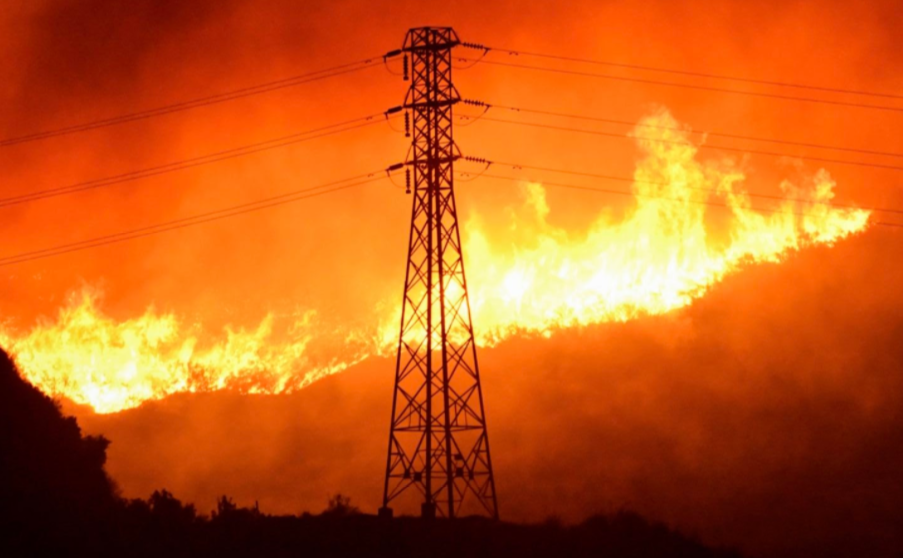
Ehrenreich, B. (2019, October 30). California Is Burning-Nationalize PG&E. Retrieved October 16, 2020, from https://www.thenation.com/article/archive/wildfires-california-pge/
The articles below continue the discussion regarding internet access as specifically tied to the Philadelphia area, which has been a theme in prior research briefs. A new initiative has been launched in Philadelphia called PHLConnectED, and it will provide internet for 35,000 families with children enrolled in the Philadelphia School District and charter schools free of charge until June 2022. Some households will be wired for free broadband access via the low cost Comcast "Internet Essentials" package, while other households that will receive free T-Mobile hotspots. This initiative also provides families access to “digital navigators” that will provide free technological support. This news comes after months of growing public concerns and pressure on Comcast to provide free internet access to families living without it, as it was estimated that thousands of students were unable to engage in remote learning in the spring because of unreliable internet access.
On Thursday, July 30th, the city of Philadelphia announced a partnership with Comcast to provide free internet to 35,000 families with students in preparation for the new fully virtual school year. Some households will receive the low cost Comcast "Internet Essentials" package while others will receive T-Mobile hotspots.
Payment for this $17 million plan comes from a mixture of philanthropists, schools, and local CARES act funding. Any family with a student enrolled in a Philadelphia public or charter school is eligible. These schools have already provided students with tablets and Chromebooks in order to connect to classes. The free internet is expected to last two years, but the door is open for this program to become permanent according to a spokesperson for the mayor.
The CARES act funds will make up $2 million of the $17 million, with no money coming from the city's general budget. Donors include The William Penn Foundation, The Neubauer Family Foundation, and The Philadelphia School Partnership. Comcast is the largest donor, donating $7 million.
"Officials estimate they will spend $7.2 million over the two years on wired internet access, $5.1 million on hot spots and $1.7 million on the digital navigator program" (Graham, 2020).
The city found itself unable to shop around and take bids on who would offer the free internet, as Comcast is the only company that provides coverage for the majority of the city. Digital Navigators were hired to discover and help families with no internet access sign up for the program and get connected. "Thirty percent of Philadelphia households with school children lack internet access, according to census data; 58% of households making under $70,000 do not have access. And there are racial disparities — 50% of Black households have internet access, while 74% of white households do." (Graham, 2020).
"The nonprofit Movement Alliance Project, which has pushed Comcast to do more to get families online, said the plan was “a notable win for Philly’s students, educators, and the community members who have been organizing and advocating to close the digital divide ahead of the upcoming school year” but said that it did not go far enough and that some students might still lack access" (Graham 2020).
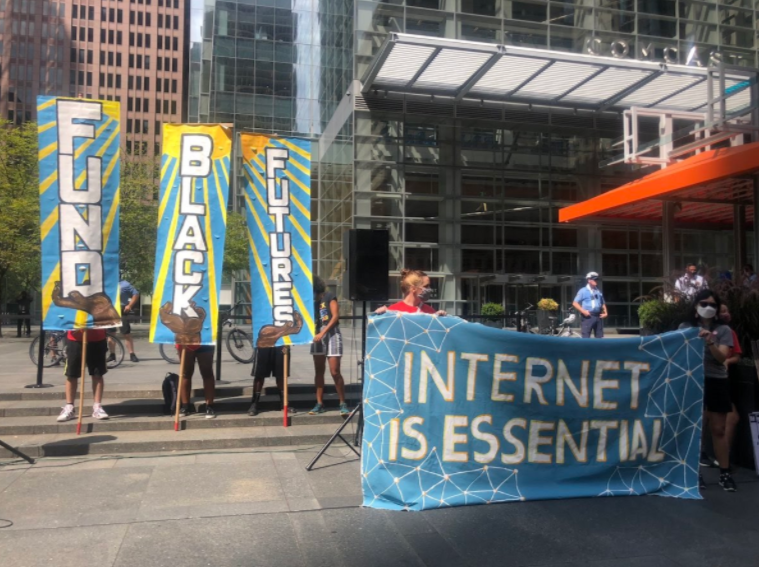
Comcast protest for free internet access brings digital divide debate to the forefront By Michael Butler / staff. Retrieved October 16, 2020, from https://technical.ly/philly/2020/08/03/comcast-protest-free-internet-acc...
A new hotline set up has been announced in Philadelphia to help students and families navigate this upcoming school year of remote learning. In this article, written by Philadelphia Mayor Jim Kenny and superintendent William Hite Jr, the term “digital divide” is frequently used, which encompasses the inequality that has become a pressing issue with online education: some don't have access to the technology needed and school districts across the country have been ill equipped to deal with this issue.
Philadelphia has been able to distribute 85,000 Chromebooks to its students thanks to the help of Philadelphia’s business community, nonprofits, and charitable foundations. A new initiative called PHLConnectED will provide internet for 35,000 families free of charge until June 2022.
The article claims the program’s swift inception was made possible by "the creative thinking, collaboration and significant commitment of time, financial resources and talent of numerous City agencies, the School District, charter school leaders, and other partners, including Comcast Corporation, The Lenfest Foundation, The Neubauer Family Foundation, The Philadelphia School Partnership, The William Penn Foundation, Hess Foundation and the Philadelphia Housing Authority all play a vital role" (Kenny and Hite).
The plan seems to use a similar foundation to the city’s previous plans regarding access to the internet. Plans for access include having individuals who have housing be provided with Comcast's Internet Essentials Plan and having individuals who are housing insecure be supplied with T-Mobile’s Wi-Fi hotspots.